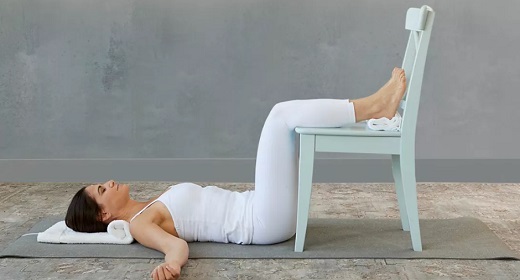by Jillian Pransky: One of the most powerful ways to feel more OK mentally and emotionally is to learn how to relax the body…
In YJ’s newest course, Restorative Yoga 101, Jillian Pransky, director of Restorative Therapeutic Yoga teacher training for YogaWorks and author of Deep Listening, will have you rethinking rest one deep breath at a time. This four-week program offers students an in-depth look at eight essential poses that will help you elicit the relaxation response, simple prop setups that will help encourage deep mind-body release and healing, guided meditative sequences and breathing exercises, mind-body alignment lectures, and personal inquiry. Eager to learn more? Sign up now.
Since one of the most powerful ways to feel more OK mentally and emotionally is to learn how to relax the body, we begin by learning how to release one of the most chronically tense muscles in everyone: the psoas.
How Your Psoas Protects You
The psoas is a long muscle that connects the legs to the spine. When you feel unsafe, this muscle contracts. In fact, it’s said to be the very first muscle that’s activated if you need to fight, flee, or freeze. All day long, the nervous system is communicating with the psoas, and the psoas is sending information back to the nervous system. Imagine walking down the street and unexpectedly a car honks at you from behind. Most people would be startled, and the fear center would immediately fire up the psoas to move the body to safety. Similarly, if you’re walking down an uneven hill and it’s hard to keep your footing, that experience of being off balance is perceived by the psoas, and it not only engages to stabilize you, it’s also part of the communication loop that gives your brain the signal that you’re on unsafe ground.
How Modern Life Creates a Chronically Tense Psoas
This mind-body communication system gets complicated when your daily habits affect messages to and from your psoas. In fact, this muscle becomes constricted not only when you feel threatened, but from things most people do every single day. For instance, it tightens when you sit for too long, when you drive, and when you walk on concrete. Because it attaches in the midsection, a tight psoas can cause back pain, hip pain, and even hamper digestion. As extreme as it sounds, this muscle can affect so many of the body’s systems that when it’s chronically constricted, it can leave you physically uncomfortable and even feeling unsettled and anxious. Since the top of the psoas attaches to the spine right around the diaphragm, when the psoas contracts it pulls on the spine, limiting spinal movement, which in turn restricts the movement of the diaphragm. The less freely the diaphragm moves, the less easily you breathe and the more anxious you feel.
How to Release Tension in the Psoas
When the psoas is constricted, it’s simply hard to sense yourself truly landing on the ground. But when the psoas is supple and pliable, it allows you to feel grounded—like you belong on the earth. However, because the psoas is activated by your fear circuitry and the stress response, it holds a lot of “tension” (rigidity from the psycho-emotional response) rather than more straightforward “tightness” (shortening of the muscle from exercise or overuse). Tension can’t be stretched—it needs time, care, and safety to unravel.
How Modern Life Creates a Chronically Tense Psoas
This mind-body communication system gets complicated when your daily habits affect messages to and from your psoas. In fact, this muscle becomes constricted not only when you feel threatened, but from things most people do every single day. For instance, it tightens when you sit for too long, when you drive, and when you walk on concrete. Because it attaches in the midsection, a tight psoas can cause back pain, hip pain, and even hamper digestion. As extreme as it sounds, this muscle can affect so many of the body’s systems that when it’s chronically constricted, it can leave you physically uncomfortable and even feeling unsettled and anxious. Since the top of the psoas attaches to the spine right around the diaphragm, when the psoas contracts it pulls on the spine, limiting spinal movement, which in turn restricts the movement of the diaphragm. The less freely the diaphragm moves, the less easily you breathe and the more anxious you feel.
How to Release Tension in the Psoas
When the psoas is constricted, it’s simply hard to sense yourself truly landing on the ground. But when the psoas is supple and pliable, it allows you to feel grounded—like you belong on the earth. However, because the psoas is activated by your fear circuitry and the stress response, it holds a lot of “tension” (rigidity from the psycho-emotional response) rather than more straightforward “tightness” (shortening of the muscle from exercise or overuse). Tension can’t be stretched—it needs time, care, and safety to unravel.



















































